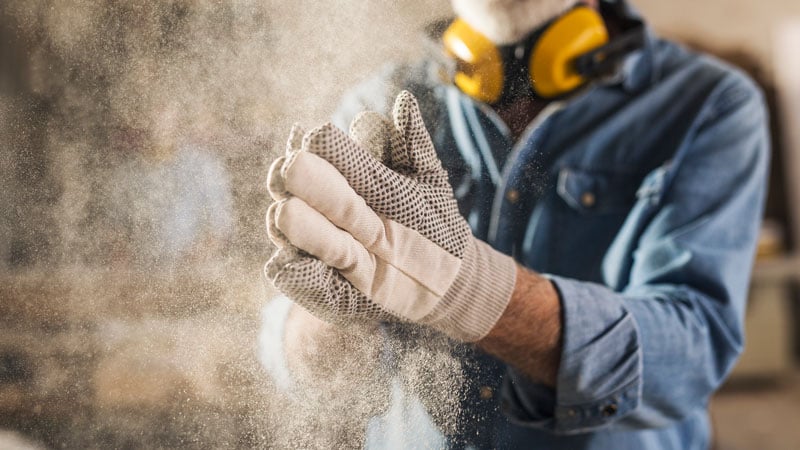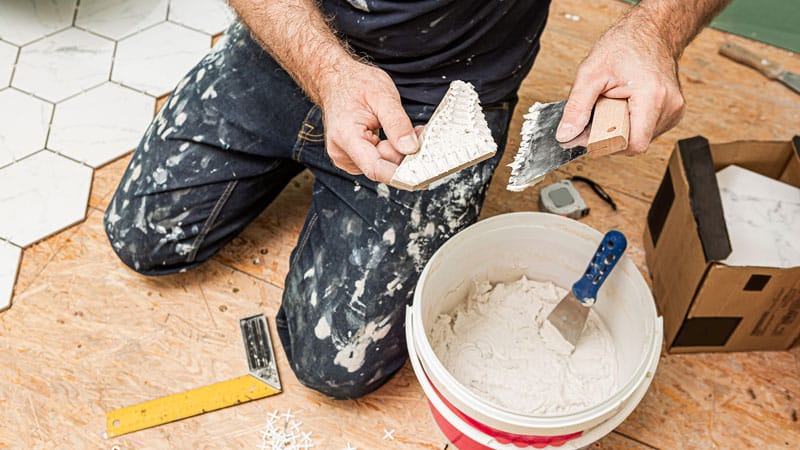Carpenters regularly risked asbestos exposure on the job, which increased their risk of mesothelioma. Today, many of these workers, and people doing DIY work or woodworking projects on their homes are still at risk because asbestos lingers in older buildings. Victims of asbestos exposure in carpentry and construction could be eligible for compensation.

How Do Carpenters Get Exposed to Asbestos?
Carpenters and related workers have had some of the highest risks of exposure to asbestos through their jobs. They continue to face this risk and are also at risk for asbestos illnesses like mesothelioma.
Airborne Asbestos Fibers
When asbestos is disturbed, such as during carpentry or renovation work, the fibers enter the air as a type of dust. If not adequately protected, anyone in the vicinity inhales the fibers. Consumption of the fibers is a less common route of entry into the body.
Carpentry, construction, home renovation, and other types of woodworking commonly disturb materials. Workers cut, sand, and otherwise manipulate materials to do their jobs. If any of those materials contain asbestos, fibers enter the air and put workers at risk of exposure.
Traditional Use of Asbestos in Construction and Carpentry
The useful properties of asbestos led to its heavy use in the construction industry. Although it has been in use for hundreds of years, manufacturers of construction materials began using it more heavily in the late 1800s, particularly during and after World War II.[1]
Manufacturers used asbestos to strengthen construction materials, like cement, plastic, and wallboard. They used asbestos to insulate, fireproof, and soundproof materials going into homes and other buildings. Asbestos use was heavy in construction until the 1970s, when federal regulations began to limit it.[1]
Federal government agencies put some bans and limitations in place. For instance, the U.S. Consumer Product Safety Commission banned asbestos in gas fireplaces and wallboard patching compounds in the late 1970s, two products that affected carpenters.[1]
Is Asbestos Still Used in Construction?
While asbestos is still not banned in the U.S., it is no longer used in most new construction materials. The Environmental Protection Agency (EPA) issued a final rule in 2019 banning several asbestos products from entering the market.
Many of these affect carpenters, including adhesives and sealants, cement products, millboard, friction materials, and some roofing and flooring materials. The EPA already banned corrugated paper, rollboard, commercial paper, and flooring felt containing asbestos.
Are Carpenters and Wood Workers Still at Risk of Asbestos Exposure?
New products are less of a problem for carpenters than older products. According to the Agency for Toxic Substances and Disease Registry, construction trades currently have the highest risks of asbestos exposure compared to other careers.
Millions of people in this industry are still at risk because of the asbestos materials that linger in older buildings.[2]
Workers in construction and carpentry have a right to a safe workplace. They must be provided with safety training and equipment when working with asbestos. If you work in these trades and your employer is not following safety regulations, you can file a complaint with the Occupational Safety and Health Administration.[3]

What Carpentry Products Have Asbestos?
Carpenters continue to face asbestos exposure risks on the job because of these lingering asbestos materials in older buildings. Construction products and materials that could contain asbestos include:[4]
- Insulation in attics, walls, and around pipes
- Cement pipes
- Vinyl floor tiles
- Flooring adhesive
- Roofing materials
- Siding shingles
- Textured paint and ceiling treatments
- Patching compounds
- Millboard, paper, and cement sheets around wood-burning stoves
- Components in furnaces, such as door gaskets
- Boilers and water heater components
- Electrical conduits
- Electrical paper
- Electrical wire insulation
- Cement electrical shielding and molded bases
- Fireproof textiles, such as curtains
- Textiles and cushions in furniture
Which Companies Made Construction and Carpentry Products with Asbestos?
Carpenters were exposed to asbestos through materials supplied to construction jobs. Some of the major suppliers of asbestos construction materials were:
- Johns Manville
- Georgia Pacific
- Congoleum Corporation
- Armstrong World Industries
- Bondex International
- Owens-Corning/Kaylo
- Turner & Newall
- Kentile Floors
- Kaiser Gypsum Company
- UNARCO
- CertainTeed Corporation
- Bestwall Gypsum
- National Gypsum
Carpentry and Wood-Related Careers with Asbestos Exposure Risk
Carpenters face some of the highest risks of asbestos exposure in the construction industry. There are many other workers in construction and related fields who also face exposure and later illness:
- Home builders and developers
- Electricians and plumbers
- Construction laborers
- Demolition workers
- Home renovation workers
- Furniture restoration workers
- Flooring installers
- Roofing installers
- Lumber industry workers
Carpenters and Mesothelioma – What Does the Research Say?
Several studies have proven that carpenters and related workers have some of the highest exposure risks and illness rates:
- A 2018 study from the UK found that the lifetime risk of mesothelioma in people with some asbestos fibers in their lungs is in carpenters born in the 1940s.[5]
- An earlier study in the U.S. examined 631 construction carpenters. The researchers found significant levels of pleural plaques in the participants, lesions that can become mesothelioma.[6]
- A survey from the UK found that the career most strongly associated with asbestos illnesses is carpentry, followed by other construction jobs.[7]
Carpenters Involved in Asbestos Lawsuits
Many of the carpenters exposed to asbestos on the job sued the manufacturers that supplied their worksites with asbestos materials:
- Searr Delcambre worked as a carpenter and general laborer for many employers and eventually died from an asbestos-related disease. His family filed a wrongful death lawsuit against several asbestos manufacturers known to have supplied construction sites. The outcome of the lawsuit remained private.
- David Konstantin worked as a carpenter in New York in the 1970s and died from mesothelioma. His widow filed a lawsuit against asbestos companies. She stated that Konstantin worked around drywall crews who sanded and produced a lot of dust. She won an $8 million jury verdict for his wrongful death.
- A carpenter and maintenance worker in Mississippi worked for a construction company from the 1940s through 2011. He encountered asbestos throughout his career and eventually developed a related illness. His lawsuit resulted in an $820,000 award.
Asbestos Risk in DIY Work
It’s not only paid workers in carpentry who face asbestos risks. Anyone with a DIY home hobby could be exposed to the older materials that still contain asbestos. If you work in your home without checking for and abating asbestos, you could be exposed.
The risk comes from disturbing older asbestos materials. For instance, you might replace asbestos vinyl flooring in a kitchen but cutting it with a power tool. This will disturb the asbestos, sending fibers airborne. Insulation is another big issue.
Many older homes have asbestos insulation. Cutting into it can cause serious exposure risks. The risk is high enough that some experts predict a coming third wave of mesothelioma and other asbestos illnesses. Research in Australia has found a growing number of asbestos disease diagnoses in DIY hobbyists.[8]
If you are considering tackling DIY work on your older home or furniture, contact a licensed asbestos abatement professional first. They can find asbestos in your home and either remove it or secure it to avoid exposure.
Treatment for Carpenters Exposed to Asbestos
If you worked in this industry in the past, during peak asbestos use, talk to your doctor about appropriate screenings. The earlier doctors detect an asbestos illness, the better the overall outcome.
Mesothelioma is an aggressive cancer often diagnosed during the later stages, which limits treatment options. If you can catch it earlier, your prognosis will be better.
Treatment for mesothelioma and other asbestos illnesses should be conducted by specialists in these rare and complex illnesses. Currently, the typical treatment for mesothelioma is surgery and chemotherapy, although treatment plans vary significantly by individual.
Recent updates in mesothelioma treatment include advances in immunotherapy. These are treatments that harness the immune system to fight cancer. They show great promise and results for many patients.

Compensation for Carpenters Exposed to Asbestos
If you worked as a carpenter or in a related job and now have an asbestos illness, you have legal options. A mesothelioma lawyer can help you file a lawsuit against asbestos manufacturers to seek compensation through a settlement or jury verdict.
They can also help you find an asbestos trust fund. If you qualify, you can file a claim through a trust set up by an asbestos company that went bankrupt.
If you are a veteran and worked in a construction trade during military service, a lawyer can help you file a claim for VA benefits. You might also be eligible for a lawsuit or trust fund claim against asbestos manufacturers that supplied the military.
Asbestos exposure has long been a serious problem in carpentry and related jobs. The risk isn’t over. Understand your own risks, take steps to stay safe, and talk to an asbestos lawyer if you receive a mesothelioma diagnosis.

Mary Ellen Ellis
WriterMary Ellen Ellis has been the head writer for Mesothelioma.net since 2016. With hundreds of mesothelioma and asbestos articles to her credit, she is one of the most experienced writers on these topics. Her degrees and background in science and education help her explain complicated medical topics for a wider audience. Mary Ellen takes pride in providing her readers with the critical information they need following a diagnosis of an asbestos-related illness.

Dave Foster
Page EditorDave has been a mesothelioma Patient Advocate for over 10 years. He consistently attends all major national and international mesothelioma meetings. In doing so, he is able to stay on top of the latest treatments, clinical trials, and research results. He also personally meets with mesothelioma patients and their families and connects them with the best medical specialists and legal representatives available.
References
- National Cancer Institute. (2021, May 20). Asbestos Exposure and Cancer Risk.
Retrieved from: https://www.cancer.gov/about-cancer/causes-prevention/risk/substances/asbestos/asbestos-fact-sheet - Agency for Toxic Substances and Disease Registry. (2023, May 19). Who Is at Risk for Exposure to Asbestos?
Retrieved from: https://archive.cdc.gov/www_atsdr_cdc_gov/csem/asbestos/who_is_at_risk.html - Occupational Safety and Health Administration. (n.d.). File a Complaint.
Retrieved from: https://www.osha.gov/workers/file-complaint - Gilham, C., Rake, C., Hodgson, J. Darnton, A., Burdett, G., Wild, J.P., Newton, M. Nicholson, A.G., Davidson, L., Shires, M., Treasure, T., and Peto, J. (2018, March 9). Past and Current Asbestos Exposure and Future Mesothelioma Risks in Britain: The Inhaled Particles Study (TIPS). Int. J. Epidem. 47(6), 1745-56.
Retrieved from: https://academic.oup.com/ije/article/47/6/1745/4925430?login=false - U.S. Environmental Protection Agency. (2021, August 1). Learn About Asbestos.
Retrieved from: https://www.epa.gov/asbestos/learn-about-asbestos - Garcia-Closas, M. and Christiani, D.C. (1995, January). Asbestos-Related Disease in Construction Carpenters. Am. J. Ind. Med. 27(1), 115-25.
Retrieved from: https://pubmed.ncbi.nlm.nih.gov/7900729/ - Health and Safety Executive. (2025, July). Asbestos-Related Disease Statistics, Great Britain 2025.
Retrieved from: https://www.hse.gov.uk/statistics/assets/docs/asbestos-related-disease.pdf - Gorvett, Z. (2021, June 10). The Hobby with Hidden Health Risks. BBC.
Retrieved from: https://www.bbc.com/future/article/20210610-the-hidden-ways-diy-can-harm-your-health


